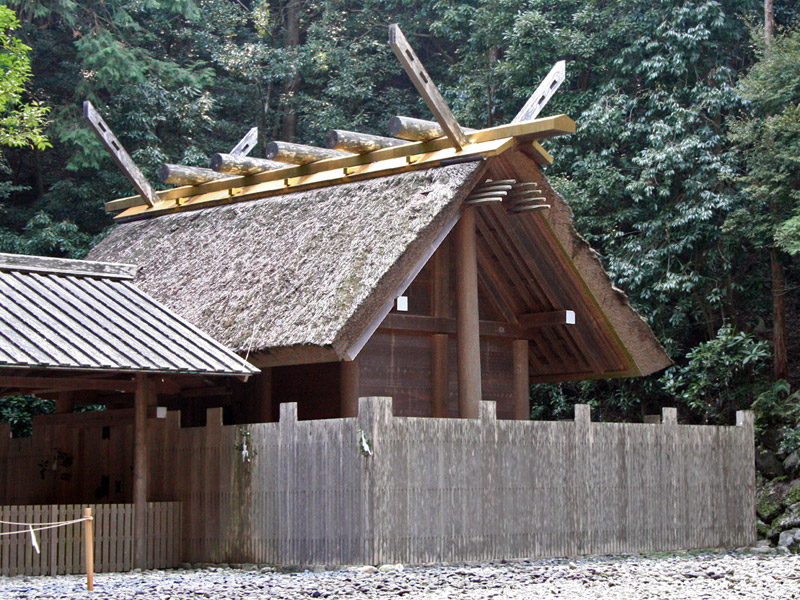| 1. An
ancient style of Shinto shrine architecture used especially for the main
sanctuary *honden {a.
It is either a small, rectangular, 3 X 2 bay building made of stripped,
untreated wood with one entrance on the long side *hirairi
½ü, or if a one bay square structure, an entrance on the side at a right
angle to the gable ends. It is raised several steps above ground level and
is surrounded by a railed veranda. The roof is a simple gable type *kirizuma
yane ØÈ®ª, covered with thatch, board, board and batten, and now
usually overlaid with copper sheeting, cypress bark or Japanese cedar shingles.
The slope of the roof may be 45Kor less. Traditionally, pillars were sunk
directly into the ground *hottatebashira
@§: where base stones are used, they are buried deeply underground so that
the pillars appear to be of the ancient sunken type. The ridge pole *munagi
Ø, receives full support from free-standing pillars, called *munamochibashira
or futabashira ñ on the gable ends. The bargeboards *hafu
j, extend beyond the ridge line to form forked finials *chigi
çØ. In most cases today, the chigi are made of separate pieces, okichigi
uçØ, and are often placed to appear as if they are extensions of the bargeboards.
Eight slender members *muchikake
Ú|, four on either side, extend just below the peak of the bargeboard. A
long peaked timber *kou-ita
b or irakaooi áO¢, is laid on top of the roof to form a ridge-like
plate to carry the billets *katsuogi
Ø. Ridge protecting timbers *aori-ita
áDÂ, are inserted under this long timber and are secured by pegs *hinuki
òÑ, extending through the ridge-protecting boards into the struts that secure
the ridge. The ridge and billets are supported by struts called *hizuka
ó© which are placed between the ridgepole and the ridge-like plate. The
shinmei style is most widely seen in Mie prefecture, as exemplified
by Ise Jinguu ɨ_{, main sanctuaries, also called *shouden
³a. Other good examples are found at Nishina Shinmeiguu Honden mÈ_¾{{a (1636)
in Nagano prefecture and Atsuta Jinguu Shouden Mc_{³a in Aichi prefecture. |



